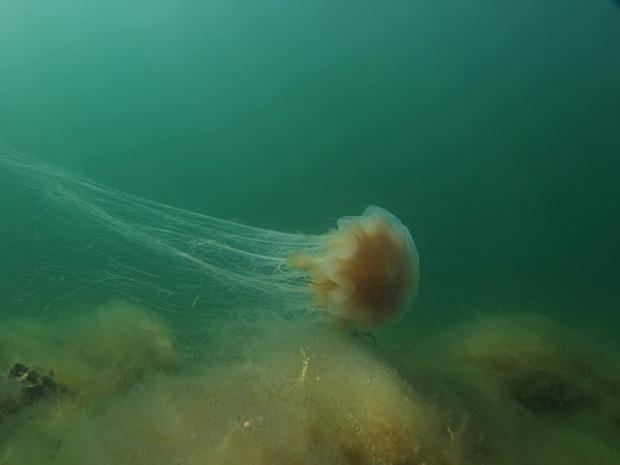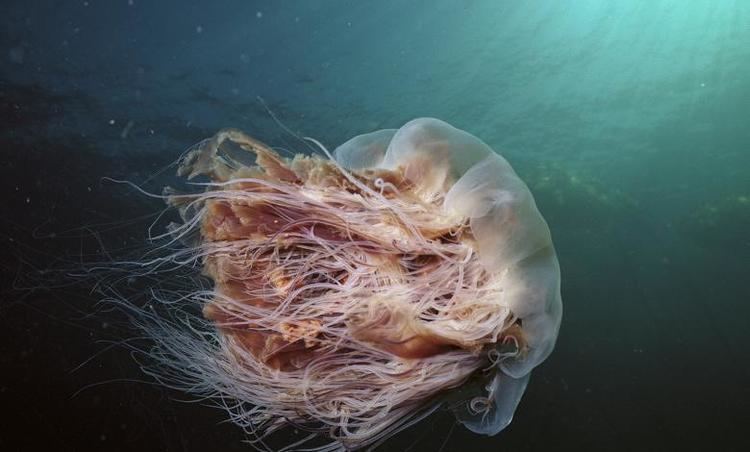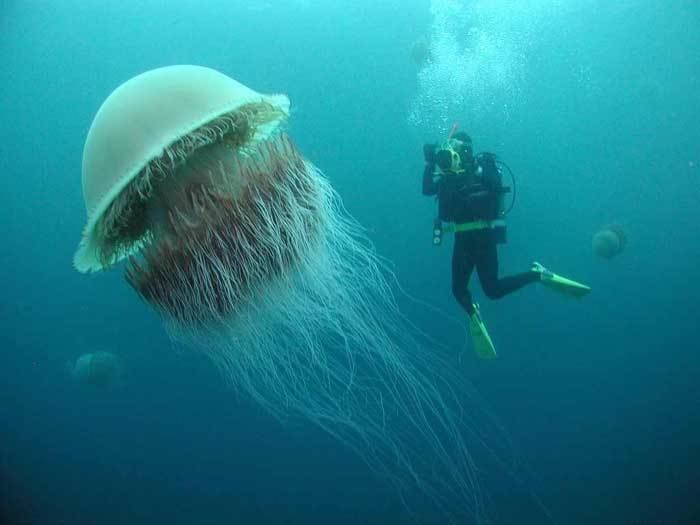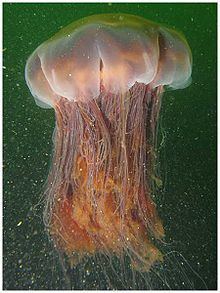Lifespan 12 months Higher classification Cyanea | Scientific name Cyanea capillata Rank Species | |
 | ||
Diameter 50 cm (In lower latitudes) Similar | ||
Giant lion s mane jellyfish
The lion's mane jellyfish (Cyanea capillata), also known as the giant jellyfish or the hair jelly, is the largest known species of jellyfish. Its range is confined to cold, boreal waters of the Arctic, northern Atlantic, and northern Pacific Oceans. It is common in the English Channel, Irish Sea, North Sea and in western Scandinavian waters south to Kattegat and Øresund. It may also drift in to the south-western part of the Baltic Sea (where it cannot breed due to the low salinity). Similar jellyfish, which may be the same species, are known to inhabit seas near Australia and New Zealand. The largest recorded specimen found, washed up on the shore of Massachusetts Bay in 1870, had a bell with a diameter of 2.3 metres (7 ft 6 in) and tentacles 37.0 m (121.4 ft) long. Lion's mane jellyfish have been observed below 42°N latitude for some time in the larger bays of the east coast of the United States.
Contents
- Giant lion s mane jellyfish
- Big lion s mane jellyfish
- Taxonomy
- Description
- Ecology
- Behavior and reproduction
- Sting and human contact
- In popular culture
- References

The lion's mane jellyfish uses its stinging tentacles to capture, pull in and eat prey such as fish, sea creatures and smaller jellyfish.
Big lion s mane jellyfish
Taxonomy

The taxonomy of the Cyanea species is not fully agreed upon; some zoologists have suggested that all species within the genus should be treated as one. Two distinct taxa, however, occur together in at least the eastern North Atlantic, with the blue jellyfish (Cyanea lamarckii Péron & Lesueur, 1810) differing in blue (not red) color and smaller size (10–20 cm diameter, rarely 35 cm). Populations in the western Pacific around Japan are sometimes distinguished as Cyanea nozakii Kisinouye, 1891, or as a race, Cyanea capillata nozakii.
Description

Although capable of attaining a bell diameter of over 2 metres (6 ft 7 in), these jellyfish can vary greatly in size; those found in lower latitudes are much smaller than their far northern counterparts with bell about 50 centimetres (20 in) in diameter. The tentacles of larger specimens may trail as long as 30 m (100 ft) or more. These extremely sticky tentacles are grouped into eight clusters, each cluster containing over 1,000,000 tentacles, arranged in a series of rows.

At 37 m (120 ft) in length, the largest known specimen was longer than a blue whale and is considered one of the longest known animals in the world. However, it might not be the longest: in 1864, a bootlace worm (Lineus longissimus) was found washed up on a Scottish shore that was 55 m (180 ft) long. But because bootlace worms can easily stretch to several times their natural length, it is possible the worm did not actually grow to be that length.
The bell is divided into eight lobes. A tangled arrangement of colorful arms emanates from the centre of the bell, much shorter than the silvery, thin tentacles which emanate from the bell's subumbrella.
Size also dictates coloration – larger specimens are a vivid crimson to dark purple while smaller specimens grade to a lighter orange or tan. These jellyfish are named for their showy, trailing tentacles reminiscent of a lion's mane.
Ecology
As coldwater species, this jellyfish cannot cope with warmer waters. The jellyfish are pelagic for most of their lives but tend to settle in shallow, sheltered bays towards the end of their one-year lifespan. In the open ocean, lion's mane jellyfish act as floating oases for certain species, such as shrimp, medusafish, butterfish, harvestfish, and juvenile prowfish, providing both a reliable source of food and protection from predators.
Predators of the lion's mane jellyfish include seabirds, larger fish such as Ocean sunfish, other jellyfish species, and sea turtles. The Leatherback sea turtle feeds almost exclusively on them in large quantities during the summer season around Eastern Canada. The jellyfish themselves feed mostly on zooplankton, small fish, ctenophores, and moon jellies.
Behavior and reproduction
Lion's mane jellyfish remain mostly very near the surface at no more than 20 m depth, their slow pulsations weakly driving them forwards; they depend on ocean currents whereby they travel great distances. The jellyfish are most often spotted during the late summer and autumn, when they have grown to a large size and the currents begin to sweep them to shore.
Like other jellyfish, Lions manes are capable of both sexual reproduction in the medusa stage and asexual reproduction in the polyp stage. Lion's mane jellyfish have four different stages in their year-long life span: a larval stage, a polyp stage, an ephyrae stage, and the medusa stage. The female jellyfish carries its fertilized eggs in its tentacle where the eggs grow into larva. When the larva are old enough, the female deposits them on a hard surface where the larva soon grow into polyps. The polyps begin to reproduce asexually, creating stacks of small creatures called ephyrae. The individual ephyrae break off the stacks, where they eventually grow into the medusa stage and become full grown jellyfish.
Sting and human contact
Most encounters cause temporary pain and localized redness. In normal circumstances, and in healthy individuals, their stings are not known to be fatal. Vinegar can be used to deactivate the nematocysts, but due to the large number of tentacles medical attention is recommended after exposure.
On July 21, 2010, around 150 people are thought to have been stung by the remains of a lion's mane jellyfish that had broken up into countless pieces in Rye, New Hampshire, in the United States. Considering the size of the species, it is possible that this mass incident was caused by a single specimen.
In popular culture
The lion's mane jellyfish appears in the Sherlock Holmes short story "The Adventure of the Lion's Mane" published in The Case-Book of Sherlock Holmes. Holmes discovers at the end of the story that the true killer of a school professor who died shortly after going swimming (shouting "the lion's mane" before he succumbed) was actually this jellyfish. Suspicion was originally laid upon the professor's rival in love, until the latter was similarly attacked (he survived, although badly stung). In the context of the story, it is only because the school professor has a weak heart that he succumbs, as is confirmed by the survival of the second victim.
On the popular television program QI the show claimed that the longest animal in the world was the lion's mane jellyfish. While being longer than a blue whale, this is not the longest animal and was later corrected – the longest in the world is actually the bootlace worm.
